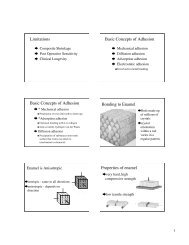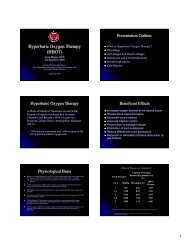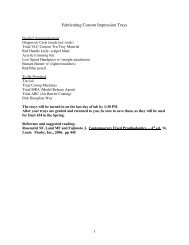Management of the deep carious lesion and the - Ohio State ...
Management of the deep carious lesion and the - Ohio State ...
Management of the deep carious lesion and the - Ohio State ...
You also want an ePaper? Increase the reach of your titles
YUMPU automatically turns print PDFs into web optimized ePapers that Google loves.
TABLE<br />
Summary <strong>of</strong> studies examining partial caries removal.<br />
Fairhurst’s group followed up <strong>the</strong>se patients<br />
across <strong>the</strong> next decade, 3,4 finally observing that<br />
“<strong>the</strong> bonded <strong>and</strong> sealed composite restorations<br />
placed over <strong>the</strong> frank cavitated <strong>lesion</strong>s [had]<br />
arrested <strong>the</strong> clinical progress <strong>of</strong> <strong>the</strong>se <strong>lesion</strong>s for<br />
10 years.” 4<br />
The r<strong>and</strong>omized controlled trial conducted by<br />
Ribeiro <strong>and</strong> colleagues, 5 in which <strong>the</strong>y evaluated<br />
<strong>the</strong> performance <strong>of</strong> a dentin adhesive system, also<br />
served to test <strong>the</strong> relative performance <strong>of</strong> com-<br />
CLINICAL PRACTICE CRITICAL REVIEW<br />
STUDY STUDY DESIGN FOLLOW-UP PERIOD RESULTS<br />
R<strong>and</strong>omized Controlled Trials<br />
Mertz-Fairhurst <strong>and</strong> colleagues 2-4 Split-mouth r<strong>and</strong>omized<br />
trial <strong>of</strong> 156 pairs <strong>of</strong> teeth,<br />
in subjects aged 8 through<br />
52 years, comparing sealed<br />
resin-based composites<br />
after partial caries removal<br />
versus sealed <strong>and</strong> unsealed<br />
amalgams after complete<br />
caries removal<br />
Ribeiro <strong>and</strong> colleagues 5 R<strong>and</strong>omized controlled<br />
trial <strong>of</strong> 48 primary molars,<br />
in subjects aged 7 through<br />
11 years, restored with a<br />
resin-bonded composite,<br />
comparing partial versus<br />
complete caries removal<br />
Foley <strong>and</strong> colleagues 6 Split-mouth r<strong>and</strong>omized<br />
controlled trial <strong>of</strong> 88 teeth<br />
in 44 subjects aged 3.7<br />
through 9.5 years; teeth<br />
divided into four groups:<br />
complete or partial caries<br />
removal restored with<br />
copper phosphate cement<br />
with or without glass<br />
ionomer cement or<br />
amalgam<br />
Observational Studies<br />
Fairbourn <strong>and</strong> colleagues 10 Observational study <strong>of</strong> <strong>the</strong><br />
effect on cultivatable flora<br />
after partial caries removal<br />
followed by zinc oxide<br />
eugenol with or without<br />
calcium hydroxide base in<br />
40 permanent teeth<br />
Maltz <strong>and</strong> colleagues 7,9,<br />
Oliveira <strong>and</strong> colleagues 8<br />
Observational study <strong>of</strong> partial<br />
caries removal in 32<br />
subjects aged 12 through<br />
23 years<br />
Marchi <strong>and</strong> colleagues 11 Observational study <strong>of</strong> <strong>the</strong><br />
effect <strong>of</strong> calcium hydroxide<br />
<strong>and</strong> resin-modified glass<br />
ionomer liners on indirect<br />
pulp caps <strong>of</strong> 27 primary<br />
molars in subjects aged 4<br />
through 9 years<br />
Clinical <strong>and</strong> radiographic<br />
follow-up at<br />
six months <strong>and</strong> at one,<br />
two, five <strong>and</strong> 10 years<br />
Extracted near time <strong>of</strong><br />
exfoliation <strong>and</strong> examined<br />
radiographically<br />
<strong>and</strong> via electron<br />
microscopy<br />
Restorations assessed<br />
clinically at six-month<br />
intervals for 24<br />
months <strong>and</strong> radiographically<br />
at 12 <strong>and</strong><br />
24 months<br />
At reentry after five<br />
months, <strong>the</strong> remaining<br />
infected dentin was<br />
removed <strong>and</strong> cultivated<br />
for microbiological<br />
analysis<br />
Clinical, radiographic<br />
<strong>and</strong> microbiological<br />
data collected at<br />
reentry at six to seven,<br />
14 to 18, <strong>and</strong> 36 to 45<br />
months after<br />
treatment<br />
Examined at four<br />
years for clinical or<br />
radiographic evidence<br />
<strong>of</strong> pulp pathology<br />
Copyright © 2008 American Dental Association. All rights reserved.<br />
No differences noted among<br />
groups at any time <strong>of</strong><br />
follow-up<br />
No differences noted<br />
between groups<br />
Use <strong>of</strong> copper phosphate<br />
cement plus glass ionomer<br />
cement resulted in more<br />
abscess or sinus formation;<br />
use <strong>of</strong> glass ionomer cement<br />
alone resulted in no differences<br />
between groups<br />
Nine <strong>of</strong> 20 teeth treated<br />
with calcium hydroxide <strong>and</strong><br />
five <strong>of</strong> 20 teeth treated with<br />
zinc oxide–eugenol were<br />
sterile<br />
Remineralization occurred<br />
<strong>and</strong> caries was arrested at<br />
each <strong>of</strong> <strong>the</strong> three times <strong>of</strong><br />
follow-up<br />
88 percent success for calcium<br />
hydroxide <strong>and</strong> 93 percent<br />
success for resinmodified<br />
glass ionomer<br />
plete <strong>and</strong> partial caries removal. After etching,<br />
<strong>the</strong> investigators applied a bonding agent to both<br />
<strong>carious</strong> <strong>and</strong> non<strong>carious</strong> dentin in 48 primary<br />
molars <strong>of</strong> 38 children aged 7 to 11 years. In one<br />
group, <strong>the</strong> clinicians removed <strong>carious</strong> dentin completely<br />
from <strong>the</strong> DEJ but only superficially from<br />
<strong>the</strong> remainder <strong>of</strong> <strong>the</strong> cavity; <strong>the</strong>y treated a second<br />
group by completely excavating caries. The investigators<br />
extracted 40 teeth (20 from each group)<br />
at about <strong>the</strong> time <strong>of</strong> exfoliation (approximately<br />
JADA, Vol. 139 http://jada.ada.org June 2008 707<br />
Downloaded from<br />
jada.ada.org<br />
on October 20, 2008






